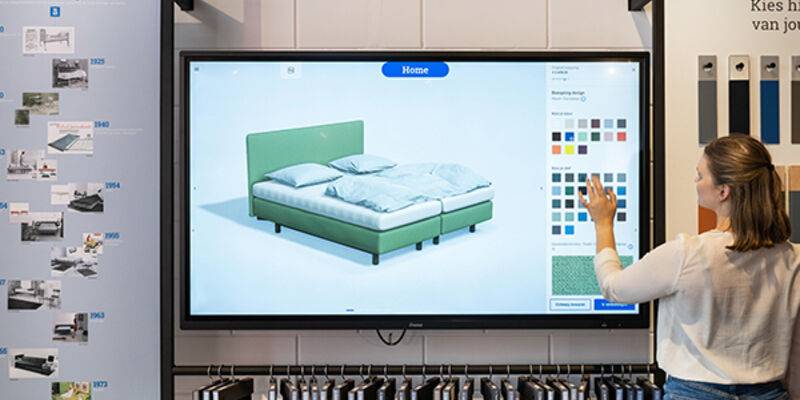How do you alert an employee when a customer needs help with a self-checkout? With Simac's help, HEMA implemented Workforce Connect for this purpose, Zebra's communication tool that turns every PDA into a walkie-talkie or telephone. HEMA is now considering using Workforce Connect for other processes as well.

HEMA's first self-checkout consisted of a regular cash register. If an employee was behind the checkout counter to help, a touch screen displayed the items scanned and the amount to be paid. If the employee was not behind the checkout, the customer could use the same checkout to pay for the groceries using the checkout scanner and touch screen.
It was a simple and effective concept, but it did not offer the efficiency HEMA had hoped for. "If a customer asked for assistance or an employee needed to perform an age check, the self-checkout sent a notification to one of the other cash registers. That meant that an employee always had to stand near the cash registers to signal these notifications," says Piet-Jan Vriend, who as product owner storetech is responsible for a number of HEMA's store systems.
PDA from Zebra
As the use of self-checkouts took off within HEMA, the need for a different solution grew. A solution that allowed employees to carry out their normal duties such as restocking shelves, but informed them immediately the moment action was required at one of the self-checkouts.
"For regular tasks, employees already had access to a PDA from Zebra. They used that device not only for restocking shelves, but also for other tasks such as checking stock and making markdowns. It was obvious to use the PDAs also for notifications from the self-checkouts."
Piet-Jan discussed the issue in the quarterly consultation with hardware supplier Zebra and system integrator Simac. In those consultations, the three parties keep each other informed of new developments. HEMA indicates what the challenges on the store floor are, while Zebra and Simac talk about new innovations and technological applications. "With both parties we have been working together for years. And that cooperation is becoming increasingly close. Zebra used to be primarily an equipment supplier. Nowadays they provide complete solutions including software and the services around it," Piet-Jan says. He is supported by Wouter Hoppenbrouwers, business development manager at Zebra: "We visit many retailers with our solutions. We see what the best practices are and share them with our customers. Not so much to deliver technology, but to make their processes better."
''Try explaining to an employee that they need a different device for each task.''
Push-to-talk
Zebra came up with an effective solution: Workforce Connect. This is a communication tool that allows store employees to easily communicate with each other via the push-to-talk principle. In addition to a voice function, Workforce Connect also offers a secure and closed environment in which employees can send each other messages. Wouter: "We see that many stores create their own group in WhatsApp for this purpose, but then they sometimes forget to remove departed employees from this group. This causes leakage of confidential and sensitive information. With Workforce Connect, this is eliminated."
Another Zebra solution, the Interworking Gateway, was used to link Workforce Connect to HEMA's checkout system. As a result, notifications of self-checkouts now also arrive as messages on the PDA. Piet-Jan: "We wanted an efficient solution that required as few changes as possible to our existing systems. With this solution and the help of Simac, we ran a pilot in two stores. When we proposed stopping it after a few weeks, the employees in both stores indicated that they wanted to keep the solution. That was the signal for us to roll out Workforce Connect further with Simac's help."
Genuine phone
Meanwhile, Cow Hills, the supplier of the POS system, has developed a separate supervisor app that alerts employees when their assistance is required. This app is now being tested on the PDAs of a number of stores. Piet-Jan is thinking about using Workforce Connect for other processes to make communication inside and outside the store more efficient.
"Mutual communication between store employees is only becoming more important. Suppose a customer comes to pick up a package that is not behind the counter. Or asks if that one shirt is in stock in a different size. Then it's nice to be able to ask an employee to look in the store warehouse. Now we use a separate walkie-talkie with earpieces for that, but that can also be done via Workforce Connect."
''We wanted an efficient solution that required as few modifications as possible.''
Another possibility is the deployment of Enterprise Voice, the solution within Workforce Connect that turns the PDA into a real phone. A phone that can also be used to make outside calls. "The advantage of this is that employees no longer need a separate DECT phone. We conducted a proof-of-concept in one store to investigate whether this solution works technically within the HEMA environment. Before we implement Enterprise Voice on a large scale, it has to be proven that the technology works."
Return on investment
As within HEMA, Zebra sees the PDA increasingly becoming the central device for execution of all store processes. "Just try explaining to an employee that he has to go to the computer in the back office to print something, grab a PDA to scan a barcode, use a walkie-talkie with earpieces to talk to colleagues, and use his own phone to look something up on the intranet. These are all stand-alone solutions that can just as easily be covered with today's powerful and multifunctional PDAs," Wouter explained.
"But if dropped, that device breaks down quickly. A PDA is robust and can take a beating. In addition, there are many other advantages to prefer an enterprise device over a smartphone. In our private lives, we use one device for almost everything. Within Zebra, we believe that in the business world there is still room for improvement in this area. An additional advantage: companies need to invest less in other hardware. This increases the 'return on investment' of the PDAs."










